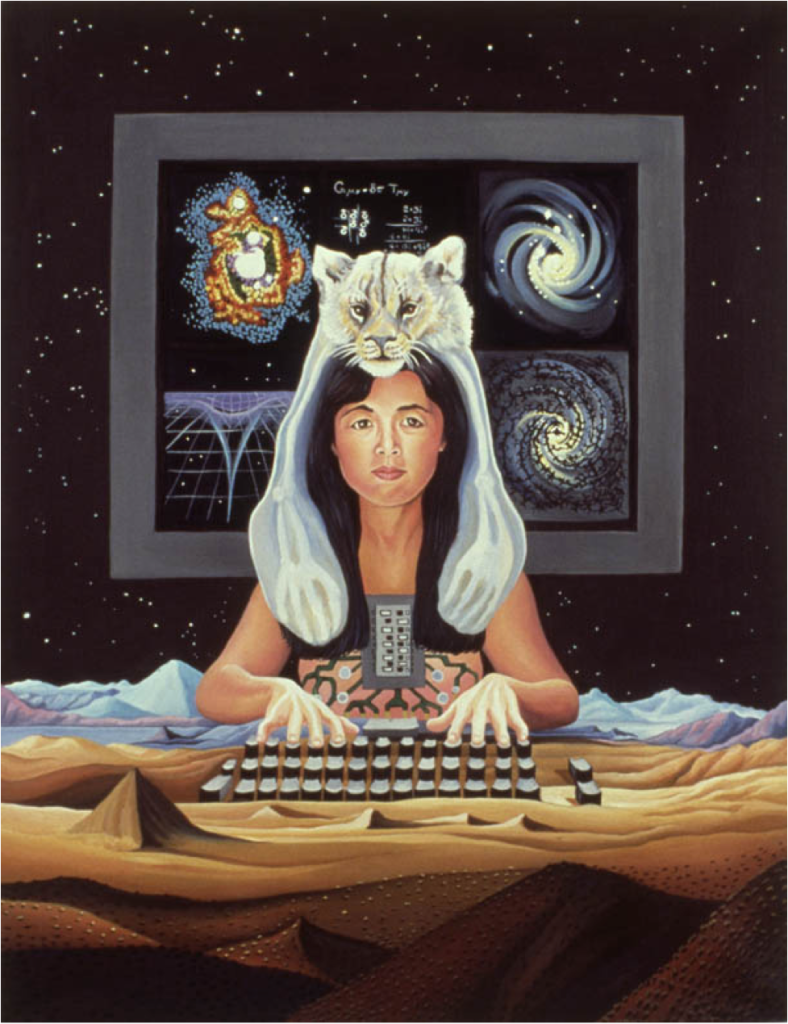Donna Haraway, A Cyborg Manifesto, Socialist Review (US), 1985
This is a short ongoing anthology that helped me understand my cyborg’s nature. There are many texts where I found guidance, and in some cases I left them behind because my identity and subjective awareness feels everything but static, given values. I like to begin with “The Cyborg Manifesto,” first published in 1985, the year I was born. I will slowly add here more recent wordings that suggested me new understandings and shaped my thinking.

The image’s alt-text, is an excerpt form Lynn Randolph’s “Modest Witnesses: A Painter’s Collaboration with Donna Haraway” in which the authors describe the composition of this painting and unpack its iconography. It feels great to find an artist creating another way to access their work, beyond vision.
Link to a digital copy of the essay, available on Internet Archive.
Donna Haraway, From Cyborgs to Companion Species: Dogs, People, and Technoculture, September 16, 2003.
Disability Justice Resource Directory
This is a (non-exhaustive, ever evolving) curation of disability justice tools, resources, and best practices curated by the Creating Freedom Movements #MoreJusticeMoreJoy
Artist Christine Sun Kim Rewrites Closed Captions
Video description and transcript are available.
Further information and full credits are in the description of the original post, published by Pop-Up Magazine on their YouTube channel.
Activating Captions
Curated by artist Christine Sun Kim and ARGOS director Niels Van Tomme, “Activating Captions” is an online platform that critically engages with captioning as a singular artistic form of expression. The process of converting audio and visual material into text through a display system is essential – the curators note – ‘for the Deaf and Hard-of-Hearing, as well as numerous others, such as people who are learning a new language’. There is an online magazine featuring texts from art writers, scholars, and poets that reflect on captioning from personal perspectives and experiences.
A gem that may go unnoticed on the online platform is the Accessibility Resources index. Among the links, there is “Alt-Text As Poetry Workbooks” by Shannon Finnegan and Bojana Coklyat – I will do those exercises again!
Infinite Ear: A Reader
On the occasion of the exhibition WITHIN / Infinite Ear, Bergen Assembly, 2016 Emma McCormick-Goodhart in collaboration with Grégory Castéra selected a series of texts and published a reader that follows these categories:
GESTURE/ASSEMBLY
MECHANISM/APPARATUS
UNSOUND/(IM)PERCEPTION
PROSTHESIS/DEVICE
INTERARTICULATION
ARCHITECTURE/ACOUSTICS
MIND’S EAR
MATTER/NOISE
TACTILITY
PARA-HEARING/IMAGINARY